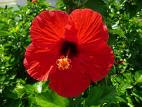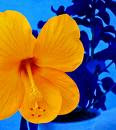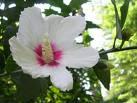::::::::::::::::::::::::::::::::::::::::::::::::::::::::::::::::::::::::::::::::::::::::::::::::::::
Hibiscus (bussooge)
***** Location: Japan, Yemen
***** Season: Late Summer
***** Category: Plant
*****************************
Explanation
hibiscus, bussooge 仏桑花 (ぶっそうげ)
fusooka 扶桑花(ふそうか)
kookin 紅槿(こうきん)
"rose of sharon from Okinawa", ryuukyuu mukuge
琉球木槿(りゅうきゅうむくげ)
also called : Rose of China, rosa sinensis
haibisukasu ハイビスカス, はいびすかす


Hibiscus, or rosemallow, is a large genus of about 200–220 species of flowering plants in the family Malvaceae (the mallow family, along with members like cocoa, cotton, okra, baobab and durian) native to warm temperate, subtropical and tropical regions throughout the world. The genus includes both annual and perennial herbaceous plants, and woody shrubs and small trees.
The leaves are alternate, simple, ovate to lanceolate, often with a toothed or lobed margin.
The flowers are large, conspicuous, trumpet-shaped, with five or more petals, ranging from white to pink, red, purple or yellow, and from 4-15 cm broad.
The Hibiscus rosa-sinensis (Bunga Raya or "Chinese hibiscus") is the national flower of Malaysia.
The ma‘o hau hele (Hibiscus brackenridgei) is the state flower of Hawai‘i.
The Hibiscus syriacus (Mugunghwa or "Rose of Sharon") is the national flower of South Korea.
The Native Hibiscus is a national emblem of the Stolen Generation of indigenous peoples in Australia. Its colour denotes compassion and spiritual healing.
© More in the WIKIPEDIA !
::::::::::::::::::::::::::::::::::::::::::::::::::::::::::::::::::::::::::::::::::::::::::::::::::::
kigo for late summer
ooshokki 黄蜀葵 (おうしょっき) Tororo aoi
..... tororo aoi とろろあおい (also Nebishi)
Abelmoschus manihot Medic. (Hibiscus manihot L.)
. . . CLICK here for Photos !
ginsenka 銀盞花 (ぎんせんか) Flower-of-the-hour
..... fueisoo 富栄草(ふえいそう)
..... choorosoo 朝露草(ちょうろそう) "morning dew plant"
Hibiscus trionum
.................................................................................
kigo for all winter
tororo aoi tsuku 黄蜀葵搗く (とろろあおいつく)
pounding tororo aoi
kan nori 寒糊 (かんのり) glue made in the cold
from the root of the Tororo aoi plant.
This plant is used to make Japanese paper.
WKD : Paper making and related kigo
*****************************
Worldwide use
Yemen
topic for the whole year
Many are familiar with the striking flowers of the hibiscus which can be seen swaying freely in the breeze. It is not really surprising that the name is attributed the meaning of "delicate beauty". There are thousands of hues and combinations involving six basic colors in the color pattern, white, yellow, orange, pink and brown. The flowers can be singles or doubles. The hibiscus, an evergreen shrub, reaches about four meters.
© When Yemen Blooms
Akhraba's rose of sharon
circling
on my way home
Heike Gewi, Yemen 2008
YEMEN SAIJIKI
*****************************
Things found on the way
*****************************
HAIKU
仏桑花六月晦日年の臍
bussooge rokugatsu misoka toshi no heso
hibiscus
last day of June
the navel of the year
Fuuten Tora
© おしゃべり日記俳句
***************************************
Related words
***** Rose of Sharon, althea, mukuge 木槿
kigo for early autumn
mokuge


fence with the rose of Sharon,
mukuge gaki 木槿垣(むくげがき)
white rose of Sharon, shiro mukuge白木槿(しろむくげ)
red rose of Sharon, beni mukuge 紅木槿(べにむくげ)
blossoms of the rose of Sharon, hana mukuge
花木槿(はなむくげ)、kihachisu きはちす
quote
- The Complete Works Of Chuang Tzu -
Little understanding cannot come up to great understanding;
the shortlived cannot come up to the long-lived.
How do I know this is so? The morning mushroom knows nothing of twilight and dawn; the summer cicada knows nothing of spring and autumn. They are the short-lived. South of Ch'u there is a caterpillar which counts five hundred years as one spring and five hundred years as one autumn.
Long, long ago there was a great rose of Sharon that counted eight thousand years as one spring and eight thousand years as one autumn. They are the long-lived. Yet P'eng-tsu alone is famous today for having lived a long time, and everybody tries to ape him. Isn't it pitiful!
Translated by Burton Watson
source : terebess.hu
. Chinese background of Japanese kigo .
.................................................................................
The Rose of Sharon is a flower of uncertain identity mentioned in English language translations of the Bible. The word in question is the Hebrew, which has been uncertainly linked to the words, meaning 'bulb', and , which is understood as meaning either 'pungent' or 'splendid'. The name first appears in 1611, when it was used in the King James Version of the Bible. According to an annotation at Song of Solomon 2.1 by the translation committee of the New Revised Standard Version, this is a mistranslation of the Hebrew word for "crocus".
Today, the name is also commonly applied to two different plants, neither of which is likely to have been the plant from the Bible:
Hypericum calycinum, an evergreen flowering shrub native to southeast Europe and southwest Asia, and the plant generally referred to in British and Australian English as "Rose of Sharon";
and
Hibiscus syriacus, a deciduous flowering shrub native to east Asia, the plant generally referred to in American English as "Rose of Sharon" and the national flower of South Korea. The flower's name in Korean is mugunghwa (Korean Hangul: 무궁화, Hanja: 無窮花).
© More in the WIKIPEDIA !
道のべの木槿は馬にくはれけり
michinobe no mukuge wa uma ni kuwarekeri
Blooming by the road
mallow flowers
eaten by the horse
Matsuo Basho
Tr. Bin AKIO
roadside rose of
sharon devoured
by my horse
Tr. Barnhill
by the road
a rose mallow ... it has been
eaten by my horse!
Tr. Ueda
As for the hibiscus
on the roadside—
my horse ate it.
Tr. Hass
Am Straßenrand
die Sharonrose, von meinem Pferd
gefressen
Tr. Udo Wenzel
The cut marker KERI is at the end of line 3.
Nozarashi Kiko
On the day of crossing the river Oigawa 大井川.
. Matsuo Basho 松尾芭蕉 - Archives of the WKD .
::::::::::::::::::::::::::::::::::::::::::::::::::::::::::::::::::::::::::::::::::::::::::::::::::::

酒冷すちょろちょろ川の槿哉
sake hiyasu choro-choro kawa no mukuge kana
cooling my sake
in a bubbeling stream -
Rose of Sharon
あつぱれに咲揃ふ昼の槿哉
appare ni saki-sorou hiru no mukuge kana
splendidly blooming
en masse, midday's
roses of Sharon
Tr. David Lanoue
. Kobayashi Issa 小林一茶 - Introduction . .
:::::::::::::::::::::::::::::::::::::::::::::::::::::::::::::::::::::::::::::::::::::::::::::::::::
White hibiscus friends
Gabi Greve, August 2010
:::::::::::::::::::::::::::::::::::::::::::::::::::::::::::::::::::::::::::::::::::::::::::::::::::::
. PLANTS IN SUMMER - SAIJIKI
[ . BACK to WORLDKIGO TOP . ]
::::::::::::::::::::::::::::::::::::::::::::::::::::::::::::::::::::::::::::::::::::::::::::::::::::






3 comments:
In The Philippines, the hibiscus is called the gumamela and is very popular as a decorative bush. In the 'old days' (meaning when I was younger), women even adorned their hair with it.
I must mention, though, that on my last visit there late October last year, I didn't see any single gumamela bush at all. The city is so 'developed', with modern apartments and malls, that the bushes are now probably restricted to private gardens or backyards. I just hope it hasn't disappeared entirely. What is popular now are ferns and other plants that don't need too much attention.
Yosa Buson - glue tub
うぐいすや梅踏みこぼす糊盥
uguisu ya ume fumikobosu noridarai
this bush warbler -
it scatters plum petals
around the glue tub
nori 糊 starch, glue
himenori 姫糊 "princess nori glue"
nori uri, nori-uri 糊売り vendor of starch
himenori uri 姫糊売り
vendors in Edo
.
http://edoflourishing.blogspot.jp/2014/08/nori-starch-glue.html
.
Post a Comment